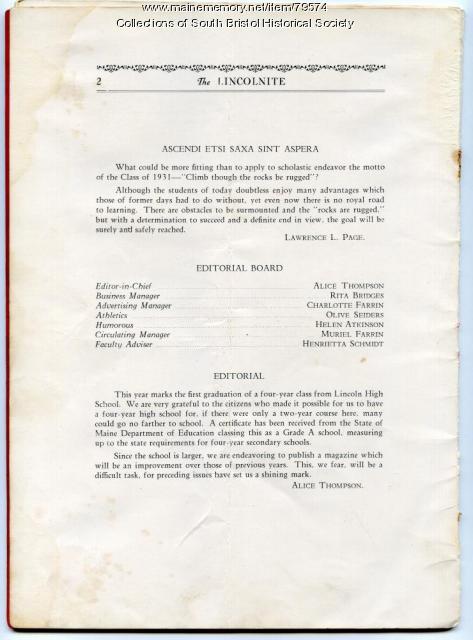Keywords: high school seniors
Item 23359
Cast of the Biddeford High School senior play, 1924
Contributed by: McArthur Public Library Date: 1924 Location: Biddeford Media: Photographic print
Item 23970
Commencement Issue of The Olympian, Biddeford High School, 1926
Contributed by: McArthur Public Library Date: 1926 Location: Biddeford Media: Paper-bound yearbook/magazine
Item 110218
Yarmouth Junior-Senior High School addition, Yarmouth, 1978-1979
Contributed by: Maine Historical Society Date: 1978–1979 Location: Yarmouth Client: Town of Yarmouth Architect: Wadsworth, Boston, Dimick, Mercer & Weatherill
Item 110242
Yarmouth Junior-Senior High School proposed addition, Yarmouth, 1972
Contributed by: Maine Historical Society Date: 1972 Location: Yarmouth Client: Town of Yarmouth Architect: Wadsworth, Boston, Dimick, Mercer & Weatherill
Exhibit
John Bapst High School was dedicated in September 1928 to meet the expanding needs of Roman Catholic education in the Bangor area. The co-educational school operated until 1980, when the diocese closed it due to decreasing enrollment. Since then, it has been a private school known as John Bapst Memorial High School.
Exhibit
Public education has been a part of Maine since Euro-American settlement began to stabilize in the early eighteenth century. But not until the end of the nineteenth century was public education really compulsory in Maine.
Site Page
John Bapst Memorial High School
View collections, facts, and contact information for this Contributing Partner.
Site Page
Life on a Tidal River - William S. Cohen, The Man and the School
"William S. Cohen graduated from Bangor High in 1958 where he was named to an all-state high school basketball team and was inducted into the New…"
Story
Quinton "Skip" Wilson: different aspects of "standing out"
by Biddeford Cultural & Heritage Center
Recollections of life as Biddeford's only student of color during the 1960-70s
Story
Biddeford and Maine Franco-American Hall of Fame Award recipient
by Biddeford Cultural & Heritage Center
With options to be a college French professor, became a lawyer, mayor, DA & District Court Judge
Lesson Plan
Grade Level: 9-12
Content Area: English Language Arts, Social Studies
Most if not all of us have or will need to work in the American marketplace for at least six decades of our lives. There's a saying that I remember a superintendent telling a group of graduating high-school seniors: remember, when you are on your deathbed, you will not be saying that you wish you had spent more time "at the office." But Americans do spend a lot more time working each year than nearly any other people on the planet. By the end of our careers, many of us will have spent more time with our co-workers than with our families.
Already in the 21st century, much has been written about the "Wal-Martization" of the American workplace, about how, despite rocketing profits, corporations such as Wal-Mart overwork and underpay their employees, how workers' wages have remained stagnant since the 1970s, while the costs of college education and health insurance have risen out of reach for many citizens. It's become a cliché to say that the gap between the "haves" and the "have nots" is widening to an alarming degree. In his book Wealth and Democracy, Kevin Phillips says we are dangerously close to becoming a plutocracy in which one dollar equals one vote.
Such clashes between employers and employees, and between our rhetoric of equality of opportunity and the reality of our working lives, are not new in America. With the onset of the industrial revolution in the first half of the nineteenth century, many workers were displaced from their traditional means of employment, as the country shifted from a farm-based, agrarian economy toward an urban, manufacturing-centered one. In cities such as New York, groups of "workingmen" (early manifestations of unions) protested, sometimes violently, unsatisfactory labor conditions. Labor unions remain a controversial political presence in America today.
Longfellow and Whitman both wrote with sympathy about the American worker, although their respective portraits are strikingly different, and worth juxtaposing. Longfellow's poem "The Village Blacksmith" is one of his most famous and beloved visions: in this poem, one blacksmith epitomizes characteristics and values which many of Longfellow's readers, then and now, revere as "American" traits. Whitman's canto (a section of a long poem) 15 from "Song of Myself," however, presents many different "identities" of the American worker, representing the entire social spectrum, from the crew of a fish smack to the president (I must add that Whitman's entire "Song of Myself" is actually 52 cantos in length).
I do not pretend to offer these single texts as all-encompassing of the respective poets' ideas about workers, but these poems offer a starting place for comparison and contrast. We know that Longfellow was the most popular American poet of the nineteenth century, just as we know that Whitman came to be one of the most controversial. Read more widely in the work of both poets and decide for yourselves which poet speaks to you more meaningfully and why.














